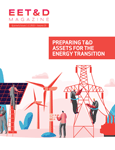Didem Cataloglu's journey into the technology sector began as she studied computer science in college. Her aptitude for writing efficient code ignited a passion for solving real-world problems through modeling and technology. Equipped with her skills and a desire to do something meaningful with them, she went on to pursue a Master of Business Administration in IT & management, enhancing her focus on leveraging technology to drive business value.
Before joining DIREXYON in 2020 as their Chief Revenue Officer, Cataloglu spent more than 20 years in global enterprises, such as Nakisa and Fresche Solutions. After establishing a highly successful customer-centric approach, that resulted in significant revenue gains for the company, Cataloglu was promoted to CEO a year later.
Now that the Infrastructure and Jobs Act has been passed, EET&D asked Cataloglu, to talk about what the transition to clean energy really means. We also asked her to share her thoughts on other topics, like what she considers the most significant industry advancement over the past five years, what projects she’s working on currently and how her approach as a woman in the electric energy sector might be different than her male counterparts. These are the highlights of our conversation:
According to Cataloglu, when talking with other industry experts about the transition to clean energy, they frequently discuss the way people use the words ‘clean’ and ‘electric’ interchangeably. “Electric energy is not synonymous with clean energy,” says Cataloglu. “But when you purchase an electric vehicle, it may not be entirely ‘clean,’ because the electricity may have been produced from fossil fuels — in which case, it may not be decreasing your overall carbon footprint to its fullest potential. Electric vehicles are certainly one step closer to achieving clean energy, but there is still plenty of work to be done. As leaders, we are responsible for educating consumers about the current situation and its impacts on future generations.”
Asked if her comments about differentiating between clean and electric energy have been met with resistance, Cataloglu says, “Most environmental, social and governance {ESG) experts agree there is a lot of work to be done toward clean energy. This is especially true in the United States, where sustainability and clean energy are urgently being prioritized.” However, as she explains, utilities are realizing there are too many complexities at play to effectively maintain the current aging infrastructure. “If we examine 2017 clean energy production data by state and analyze the trajectory adopted, we may be led to conclude that more robust technologies in asset investment planning are required to better support decision-making for capital investments and organizational objectives.”
Elaborating on what, specifically, can be done to pave the way for clean energy, Cataloglu listed what she believes are the five key considerations:
- A high-level view: Identify how you will achieve the complete transition to clean energy — not just the small incremental steps. Be prepared to endeavor beyond compliance by taking giant, proactive steps toward ESG goals.
- Digital transformation: To ensure a smooth transition to clean, start by digitalizing your organization’s guarded subject matter expertise, decision policies and data granularity. Advanced analytics will assist in precise and timely management of your clean-energy asset components and variables over the short-, medium- and long-term.
- Decarbonization and decentralization: Decide how to decarbonize over the next few decades. Focus highly on integrated processes and automation of decentralized operations. Upkeep business savviness to predict disruptions before they occur.
- Prepare today: Act now in making long-term asset investments because this shift is happening as we speak. Focus on securing the right talent and using the right technologies to make decisions that will help with more efficient handling of any potential risk that could arise — such as evolving markets and regulations.
- Investment strategy optimization: Determine milestones toward the full clean energy transition in the next five, 10 and 40 years.
Describing what she considers the most significant industry advancements over the past five years, Cataloglu points to sustainability and ESG, which she says should be top priorities for forward-looking cities and utility infrastructures. “Pledges during the recent COP26 conference, in addition to the historic U.S. infrastructure bill, are both massive steps in the right direction,” says Cataloglu. “Our job is to assist them in achieving those commitments by strategically allocating the funding, and decision-makers will need to be held accountable. The commitment to achieving net-zero emissions is about attaining results, not more capital spending. Leaders will need to generate plans for the short-, medium- and long-term to facilitate the switch.”
When it comes to her job, Cataloglu speaks with enthusiasm. She takes tremendous pride in how, by focusing on product-led growth and R&D innovations, her team delivers exceptional customer experiences, while ensuring they are prepared for a smooth and sustainable transition towards clean energy. Explaining her specific role in collaborating with her colleagues and customers, Cataloglu says, “I am passionate about my work and its diverse challenges, which require bridging the gap between technology and business. I work with a team of extremely dedicated professionals who are committed to DIREXYON’s mission of co-creating a better tomorrow. I firmly believe in inspiring the next generation of leaders, and I feel very fortunate to have them on board.”
Regarding how her approach as a female in the clean energy space may be different than her male counterparts, she says she believes in collaboration and bringing different perspectives to innovate. “The way I see it, since women comprise only 18% of the infrastructure industry workforce a greater representation of females would only benefit this industry. After all, diversity contributes to innovation. I hope to inspire more women to join typically male-dominated industries. We would ultimately be one step closer to an optimal working environment that encourages innovative ideas and more diverse perspectives.”
Cataloglu recognizes the role collaboration continues to play in the fulfillment she gets from her work. “Every day, I leverage the wisdom of leaders worldwide to guide them in rethinking their asset investment journeys,” she says. “Whether we are addressing the shift to clean energy, or maintaining their grids to meet important ESG goals, I am grateful for the opportunity to assist them in making a difference through smarter solutions.”
With an eye on the future, Cataloglu says, “My goal is to continue exploring innovative and efficient new technologies that will accelerate resilience and sustainability for tomorrow’s generation and facilitate the shift to net-zero emission objectives.”

Didem Cataloglu joined DIREXYON team as the company looks to rapidly expand. She joined DIREXYON Technologies in 2020 as Chief Revenue Officer prior to her appointment as CEO in December 2020. As CEO, Cataloglu oversees building a new sales and marketing team, delivers exceptional customer experiences and manages the company's global expansion. Before DIREXYON Technologies, she was vice president of global services for Nakisa, a provider of enterprise solutions for organizational design and lease management. She also served in various customer-facing executive roles such as vice president of professional services for Fresche Solutions and director of customer service for Fleetmind Solutions. Cataloglu holds a BSc in computer science from University of Ottawa and an MBA in management and information technology from Bayes Business School.







